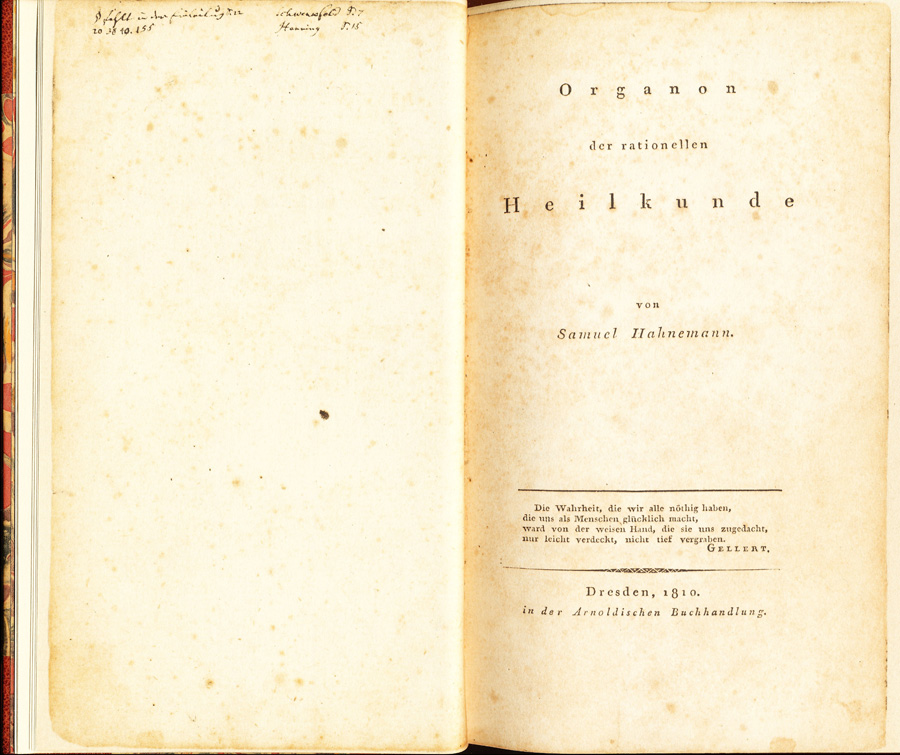New World
Siegfried Letzel
1810 – the beginning of a new world medicine
That sounds rather exaggerated, but it isn’t. Homeopathy spread across Germany, France, Europe, the USA, Canada, Brazil, and India in a relatively short period of time, and even in Hong Kong there is now a very active group of homeopaths. Homeopathy was taught as a matter of course in universities and practiced in large hospitals. However, its coexistence with so-called conventional medicine increasingly weakened from the early 20th century onwards. Despite the now high-quality, positive studies in basic research, clinical trials, and so-called outcome studies, homeopathy is being severely attacked by highly commercialized conventional medicine. Goliath is forcing David into a niche, using more or less fair means, but one in which it endures thanks to its gentle effectiveness and is highly valued by therapists, doctors, and patients.
But what about the year 1810? Well, Dr. Samuel Hahnemann’s research work during his time in Torgau was crowned with the publication of the “Organon of Rational Medicine .” He summarized this event with the following words:
“I consider it an honor to have been the only person in modern times who has undertaken a serious, honest revision of the art of medicine and presented the results of his convictions to the world’s eye, partly in anonymous and partly in authoritative publications. In these investigations, I found the path to truth, which I had to follow alone, very far removed from the general highway of medical observation. The further I progressed from truth to truth, the more my statements, none of which I accepted without empirical conviction, deviated from the old edifice, which, composed of opinions, was maintained only by opinions… The results of my convictions are contained in this book.”


In the first part of this work, he contrasted his newly discovered healing principles with conventional medical treatment and supported his teachings with numerous examples. Above all, he criticized the palliative treatment approaches of previous medicine (contraria contrariis curentur) . His truth, which he described as the ‘true healing method’, was: “In order to cure gently, quickly, and permanently, choose in every case of illness a medicine that can provoke a similar condition to the one it is intended to cure (similia similibus curentur)! No one has ever taught this homeopathic healing method before.” Hippocrates had indeed long before advised: “By applying the very substance that produces the disease, one recovers from it” – which Hahnemann fairly also quoted – but before him, no one had created a ‘pure pharmacopoeia’ (materia medica pura) that described these pathogenetic properties of medicinal substances and made them applicable according to this principle.
In order to properly acknowledge Hahnemann’s contribution to this research into a ‘calculable’ treatment of the sick, I would like to thank Dr. Richard Haehl, former owner of most of Hahnemann’s manuscripts, quotes from his Hahnemann biography (1922):
“The truth of a reliable, natural method of healing has existed from the very beginning of creation and of humanity; homeopathy is an inseparable part of creation itself. This fact was already recognized by bright minds in ancient times; buried under the rubble of the collapsed Greek culture, swept into the darkest corners by Rome’s warlike desire for world power, completely swept away by the deluge of mass migrations, it has repeatedly resurfaced in this or that enlightened mind. Thus, up to Hahnemann’s time, it has repeatedly produced individual, sensational healing successes; but these were and remained only glimpses of sunshine through the millennia-old fog of conventional prejudices and doctrines, isolated results without any connection or further justification, momentary inspirations without any scientific doctrine based on experience. Hahnemann, in his extensive and comprehensive erudition, found scattered grains of gold here and there; he continued to mine tirelessly, with almost passionate self-denial and sacrifice, and thus he finally struck the full vein of gold in solid quartz. And then his real work, his life’s work, began: the mining survey and systematic extraction. He established solid paths, carried out the entire new construction according to his well-considered plan, continually expanding and consolidating it and improving it internally; and thus he truly became the creator and father of a new healing art, the healing art of homeopathy: this is and remains his merit and his cultural-historical fame, which no one can now steal or diminish from him.
Dr. Samuel Hahnemann was neither a saint, a prophet, nor Superman. But he was a brilliant scientist who confidently rode the wave of the Enlightenment. He changed our worldview in many facets and has thus influenced our modern lives to this day. He made a significant contribution to laying the foundations of the emerging sciences. He, the translator, chemist, pharmacist, herbalist, and physician, used his knowledge to create a healthier world. It is up to us whether we are open to his healing art or not. He probably couldn’t care less. For us, however, his scientific work can contribute significantly to an improved quality of life. Let us not forget: this man lived to the age of 88 and ran a highly successful medical practice in Paris until shortly before his death on July 2, 1843. He improved and completed his Organon of Medicine up to a 6th edition, for which he wrote the last words in 1842 – and even then, it seems that he was not yet finished…
